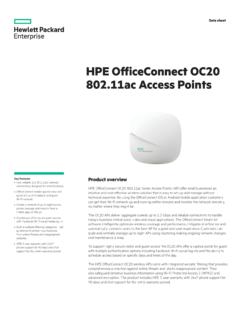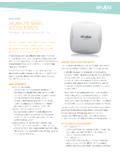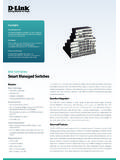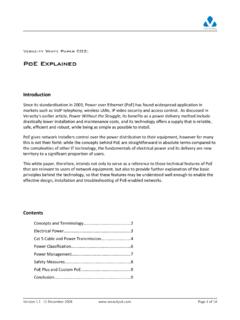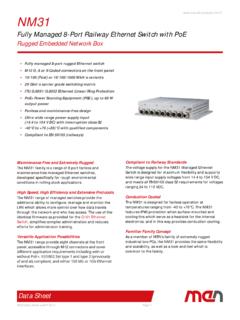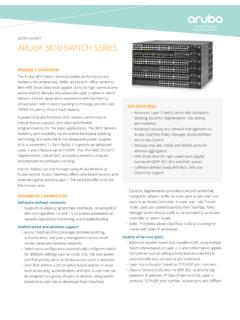Transcription of ARUBA 300 SERIES ACCESS POINTS - Aruba Networks
1 DATA SHEETThe entry-level ARUBA 300 SERIES Wave 2 ACCESS POINTS deliver high performance and superb user experience for medium density environments. Featuring 3x3:3SS MU-MIMO capability, ARUBA advanced ClientMatch radio management, and integrated ARUBA Beacons, the 300 SERIES enables an all wireless digital work environment in a cost-effective a maximum concurrent data rate of 1,300 Mbps in the 5 GHz band and 400 Mbps in the band (for an aggregate peak data rate of ), the entry-level 300 SERIES brings an always-on wireless network experience with the performance required for enterprises. It is ideal for cost-sensitive medium density environments across verticals.
2 The high performance 300 SERIES supports multi-user MIMO (MU-MIMO) and 3 spatial streams (3SS). It provides simultaneous data transmission to multiple devices (up to two), maximizing data throughput and improving network 300 SERIES includes the enhanced ClientMatch technology that extends the client steering technology with MU-MIMO client awareness. It automatically identifies MU-MIMO capable mobile devices and steers those devices to the closest MU-MIMO capable ARUBA ACCESS point. By grouping MU-MIMO capable mobile devices together, the network starts taking advantage of the simultaneous transmission to these devices, increasing its overall capacity.
3 These dynamic roaming policies that are based on device types, help customers achieve the best WLAN performance in a mixed device environment during the technology transition 300 SERIES also has an integrated Bluetooth ARUBA Beacon that simplifies the remote management of a network of large-scale battery-powered ARUBA Beacons while also providing advanced location and indoor wayfinding, and proximity-based push notification capabilities. It enables businesses to leverage ARUBA 300 SERIES ACCESS POINTSE ntry-level Wave 2 ACCESS POINTS mobility context to develop applications that will deliver an enhanced user experience and increase the value of the wireless network for BENEFITS Dual Radio ACCESS Point with Multi-User MIMO -Supports up to 1,300 Mbps in the 5 GHz band (with 3SS/VHT80 clients) and up to 400 Mbps in the band (with 2SS/VHT40 clients).
4 Built-in Bluetooth Low-Energy (BLE) radio -Enables location-based services with BLE-enabled mobile devices receiving signals from multiple ARUBA Beacons at the same time. -Enables management of your deployment of battery-powered ARUBA Beacons. Advanced Cellular Coexistence (ACC) -Minimizes interference from 3G/4G cellular Networks , distributed antenna systems and commercial small cell/femtocell equipment. Quality of service for unified communication apps. Quality of service for Unified Communication apps -Supports priority handling and policy enforcement for unified communication apps, including Microsoft Skype for Business with encrypted videoconferencing, voice, chat and desktop sharing.
5 RF Management -Adaptive Radio Management (ARM) technology automatically assigns channel and power settings, provides airtime fairness, and ensures that APs stay clear of all sources of RF interference to deliver reliable, high-performance SHEET ARUBA 300 SERIES ACCESS POINTS -The ARUBA 300 SERIES APs can be configured to provide part-time or dedicated air monitoring for spectrum analysis and wireless intrusion protection, VPN tunnels to extend remote locations to corporate resources, and wireless mesh connections where Ethernet drops are not available. Intelligent app visibility and control -AppRF technology leverages deep packet inspection to classify and block, prioritize or limit bandwidth for over 2,500 enterprise apps or groups of apps.
6 Security -Integrated wireless intrusion protection offers threat protection and mitigation, and eliminates the need for separate RF sensors and security appliances. -IP reputation and security services identify, classify, and block malicious files, URLs and IPs, providing comprehensive protection against advanced online threats. -Integrated Trusted Platform Module (TPM) for secure storage of credentials and keys. Intelligent power Monitoring (IPM): -Enables the AP to continuously monitor and report its actual power consumption and optionally make autonomous decisions to disable certain capabilities. -For the 300 SERIES APs, the IPM power -save feature applies when the unit is powered by an PoE source.
7 By default, the USB interface will be the first feature to turn off if AP power consumption exceeds the available power budget. In rare cases it may be necessary to take additional power saving measures, but in most cases, the 300 SERIES APs will operate in unrestricted YOUR OPERATING MODEA ruba 300 SERIES APs offer a choice of operating modes to meet your unique management and deployment requirements. Controller-managed mode When managed by ARUBA Mobility Controllers, ARUBA 300 SERIES APs offer centralized configuration, data encryption, policy enforcement and network services, as well as distributed and centralized traffic forwarding. ARUBA Instant mode In ARUBA Instant mode, a single AP automatically distributes the network configuration to other Instant APs in the WLAN.
8 Simply power -up one Instant AP, configure it over the air, and plug in the other APs the entire process takes about five minutes. If WLAN requirements change, a built-in migration path allows 300 SERIES Instant APs to become part of a WLAN that is managed by a Mobility Controller. Remote AP (RAP) for branch deployments. Air monitor (AM) for wireless IDS, rogue detection and containment. Spectrum analyzer, dedicated or hybrid, for identifying sources of RF interference. Secure enterprise large installations across multiple sites, the ARUBA Activate service significantly reduces deployment time by automating device provisioning, firmware upgrades, and inventory management.
9 With ARUBA Activate, Instant APs are factory-shipped to any site and configure themselves when powered SERIES SPECIFICATIONS AP-304 (controller-managed) and IAP-304 (Instant): 5 GHz 3x3 MIMO (1,300 Mbps max rate) and 2x2 MIMO (400 Mbps max rate) radios, with a total of three dual-band RP-SMA connectors for external antennas AP-305 (controller-managed) and IAP-305 (Instant): 5 GHz 3x3 MIMO (1,300 Mbps max rate) and 2x2 MIMO (400 Mbps max rate) radios, with a total of three integrated omni-directional downtilt dual-band antennasWI-FI RADIO SPECIFICATIONS AP type: Indoor, dual radio, 5 GHz 3x3 MIMO and 2x2 MIMO Software-configurable dual radio supports 5 GHz (Radio 0) and (Radio 1) 5 GHz: Three spatial stream Single User (SU) MIMO for up to 1,300 Mbps wireless data rate to individual 3x3 VHT80 client devices 5 GHz: Two spatial stream Multi User (MU) MIMO for up to 867 Mbps wireless data rate to up to two (1x1 VHT80) MU-MIMO capable client devices simultaneously.
10 Two spatial stream Single User (SU) MIMO for up to 400 Mbps wireless data rate to individual 2x2 VHT40 client devices (300 Mbps for HT40 client devices) Support for up to 255 associated client devices per radio, and up to 16 BSSIDs per radio Supported frequency bands (country-specific restrictions apply): to to to to to SHEET ARUBA 300 SERIES ACCESS POINTS Available channels: Dependent on configured regulatory domain Dynamic frequency selection (DFS) optimizes the use of available RF spectrum Supported radio technologies: : Direct-sequence spread-spectrum (DSSS) : Orthogonal frequency-division multiplexing (OFDM) Supported modulation types: : BPSK, QPSK, CCK : BPSK, QPSK, 16-QAM, 64-QAM, 256-QAM Transmit power : Configurable in increments of dBm Maximum (conducted) transmit power (limited by local regulatory requirements): band: +18 dBm per chain, +21 dBm aggregate (2x2) -5 GHz band: +18 dBm per chain, +23 dBm aggregate (3x3) -Note: conducted transmit power levels exclude antenna gain.


